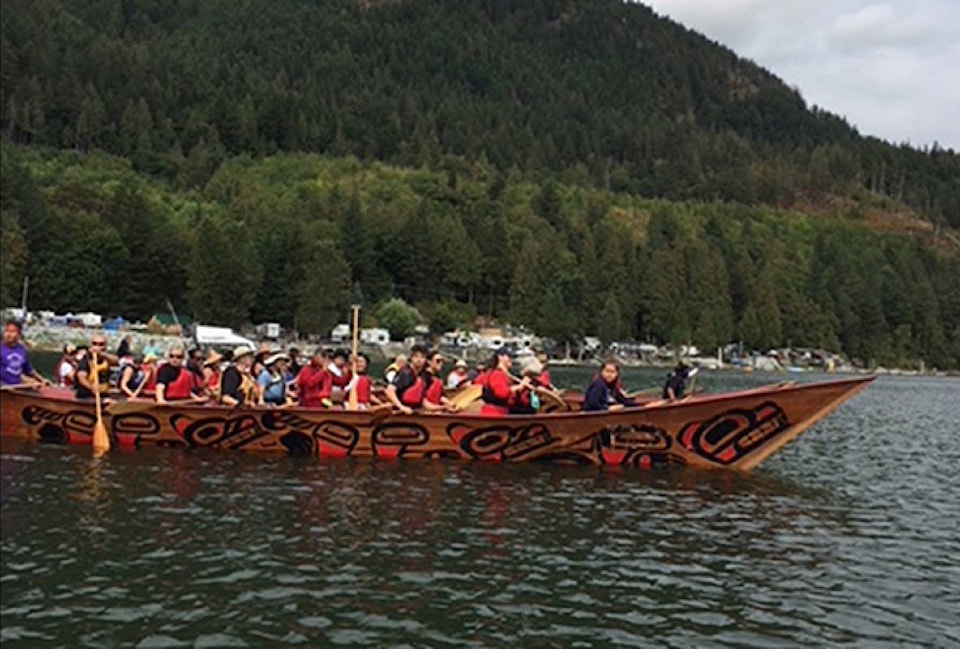The only way to bring the coho back is to repair their living environment.It’s not enough to say you can’t fish them. You have to do something to make it happen – Chief Robert Gladstone, Shxwha:y Village, near Chilliwack.
Sunday morning, excitement runs high here for “Last Stand for Wild Salmon,” subtitled, “Let’s Make the Salish Sea Fish Farm Free.”
It’s a journey by 53 paddlers – environmentalists, scientists, Shxwha:y supporters from Vancouver Island, Lower Mainland, Washington State – who hope to get fish farms out of B.C. waters.
We’ll paddle down the Fraser River in five ocean-going canoes from Harrison Bay (Lake Errock) on the north side back to Shxwha:y.
Sjxwha:y elder Eddie Gardner, who heads up the event, knows it’s a way to “do something” for the salmon that Gladstone remembers as a boy.
I’ll crew in Louise, one of ‘the three sisters’ canoes named after Shxwha:y elders. Others will paddle Wa,nukw, a Namgis canoe trailered by First Nation from Alert Bay, and a canoe from Washington which recently banned open-pen farms.
At noon, we set off by bus from Shxwha:y to Agassiz Bridge, then west on Highway 7 to Squawkim Park on Harrison Bay, Sq’elets (Scowlitz tribe) territory. We’ll put in there for our 90-minute voyage. There’s welcome talk of a “traditional feast” – salmon, oysters, clams – to celebrate after we arrive.
Scowlitz means “place to go around a bend in the river.” I have a memory of rapids worth avoiding where the Harrison meets the bigger, silty Fraser. Years ago, in a much smaller canoe, I failed to steer clear of them (stay tuned).
The Wild Salmon Defenders Alliance, a partner in today’s event, registers paddlers at Scowlitz. Since 2013, it’s campaigned against fish farms and DFO’s refusal “to test for picscine orthroreovirus before stocking pens with smolts.”
Recent research links the farms to PRV. It weakens salmon, which die of disease before spawning.
A WSDA gofundme page hopes to raise $45,000 towards court costs of First Nations contesting the presence of feed lots.
WSDA notes it involves the Dzwada’enuzw First Nation (Kingcome Inlet), who say 10 operating farms have no rights in their territory.
They’ve filed a claim of Aboriginal Title in B.C. Supreme Court “for the land and waters in and around the Broughton Archipelago.”
Arguing similar claim, the Tsihqot’in Nation (Chilcotin area) won title to 1,700 kilometres of land in a 2014 Supreme Court decision.
A second action involves the Namgis. They seek a judicial review of DFO’s policy not to test Atlantic salmon smolts from Marine Harvest Canada’s hatcheries before they’re placed in open pens.
Kurt Beardslee is director of the Wild Fish Conservancy in Washington, where last year 250,000 Atlantic salmon escaped ocean pens owned by New Brunswick-based Cooke Agriculture.
On the bus, Beardslee tells me his group also campaigned to have pens removed for years.
After the escape, WFC got 12,000 individual and 109 business signatures asking the governor to impose a ban.
“We took samples of fish recovered, 19 fish in one, five in another.
All had PRV, Beardslee says.
“It’s almost certain every fish that escaped had it. The pens have to be out by 2022. We’re hoping sooner. California, Oregon, and Alaska have already banned fish farms. Now, the entire U.S. coast won’t have them. The missing link is B.C. We owe a lot to you. Our victory in Washington started with Alexander Morton, who I’ve known for 16 years. Our scientists studied with her. We learned from your struggle. Now we have to work together to have an entire coast free of fish farms.”
At 2 p.m., we’re on the Harrison River. It’s clear. Weeds slither like snakes under us, or a giant sturgeon wishing us luck.
Scowlitz stories revere this ancient fish. Campers at Kilby Park wave greetings minutes before we reach rapids, heard before seen. As a DFO patrol officer between teaching jobs, I remember 50-pound spring salmon here leaping and crashing down thunderously.
Four canoes successfully maneuver away from the rapids, but the rough water catches Louise’s bow, pulling her in, rocking the canoe a bit, and spinning us in a circle to face dangerously upstream. It’s a tense moment. Paddles are reactively pulled up, relinquishing control of the boat.
“Don’t stop,” barks our canoe leader. “Paddle hard.”
We obey, regaining our course as a foraging seal surfaces to see what all the fuss is about.
Back in the main stream of the Fraser, the current makes going easier; time to watch eagles soar.
We’re 40 minutes to Hope Slough now, where Gladstone and others await us. Louise is last to come in.
“We are here to honor the wild salmon, our brothers, and sisters,” Gardner calls out from the canoe. “We ask permission to come ashore.”
Gladstone – following tradition – grants it.
A drum circle forms onshore. Chiefs and elders offer hope for wild salmon while sharing harrowing eyewitness accounts of grievous harm they’ve witnessed from lice and disease.
Gardner and others lead songs and thank the assembly once more. At the fire pit where the seafood was cooked, our Shxwha:y chef explains: “You lay oysters on the coals first. Their water steams the clams on top.”
There are tongues to pluck shells from the pit, but I use fingers.
“That’s the old way,” says the cook as his brush flavors sockeye fillets on his barbecue. I’ve tasted fish done this way, scales down on the grill turning crispy. Like Homer Simpson with chicken, I shamelessly plead for “extra skin please.”
At last count, Last Stand had collected about $25,000. The gofundme page remains open.
Jack Emberly is a retired teacher, local author and environmentalist.
